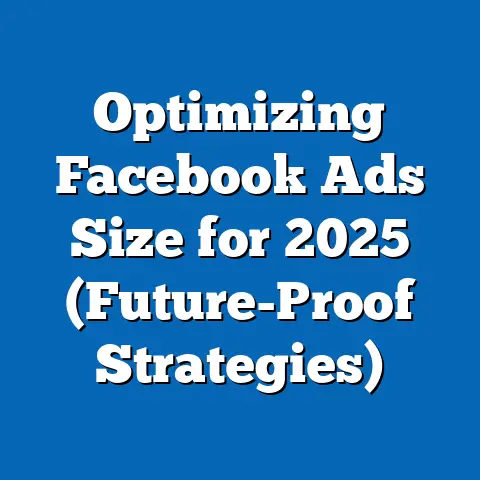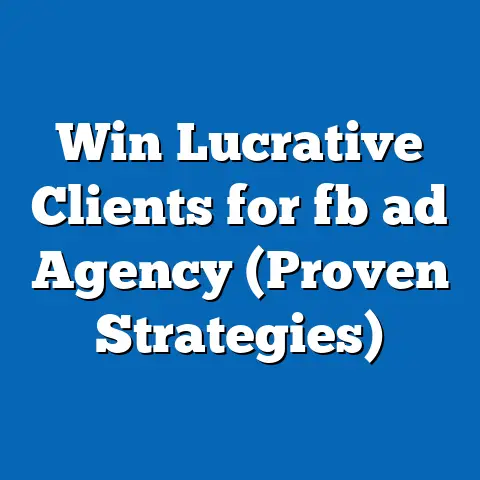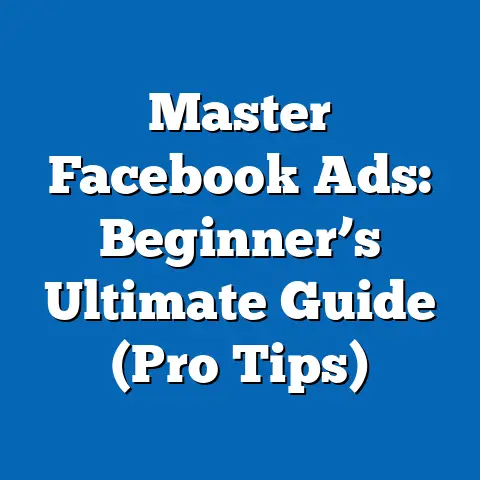Unlocking Rejected Facebook Ads (Expert Recovery Strategies)
Facebook Ads have become a cornerstone of modern digital marketing. As an advertiser, I know firsthand how crucial they are for reaching target audiences, driving conversions, and ultimately, growing your business. However, the path to Facebook Ads success isn’t always smooth. One of the most frustrating experiences for any advertiser is having their ad rejected. It’s happened to me more times than I’d like to admit! It’s not just about the immediate disruption to your campaign; it can also impact your budget, timeline, and overall marketing strategy.
But beyond simply getting your ads approved, I want to emphasize the importance of safety when running Facebook Ads. Safety goes beyond just adhering to the guidelines; it encompasses maintaining the integrity of your brand, protecting user privacy, and ensuring a positive experience for your audience. By prioritizing safety, you not only avoid rejections but also build trust and credibility with your audience, which is essential for long-term success. Let’s dive in and unlock the secrets to navigating the world of Facebook Ads with confidence and compliance!
Understanding Facebook Ads and Their Policies
Facebook Ads are a powerful tool for businesses of all sizes. They allow you to target specific demographics, interests, and behaviors, ensuring your message reaches the people most likely to be interested in your products or services. The primary objectives of advertisers often include:
- Increasing Brand Awareness: Reaching a broad audience to familiarize them with your brand.
- Generating Leads: Collecting contact information from potential customers.
- Driving Website Traffic: Sending users to your website to explore your offerings.
- Boosting Sales: Encouraging immediate purchases of your products or services.
- Promoting App Installs: Driving downloads of your mobile application.
However, to maintain a safe and positive experience for its users, Facebook has strict advertising policies. These policies cover a wide range of topics, and understanding them is crucial for avoiding ad rejection. Here are some key areas:
- Prohibited Content: This includes content that is illegal, discriminatory, or promotes violence, hate speech, or terrorism.
- Misleading Claims: Ads cannot contain false or misleading information about products, services, or business practices.
- Intellectual Property Violations: You cannot use copyrighted material without permission or infringe on trademarks.
- Community Standards: Ads must adhere to Facebook’s community standards, which prohibit content that is offensive, harassing, or bullying.
- Personal Attributes: Ads cannot directly or indirectly assert or imply a person’s race, ethnic origin, religion, beliefs, age, sexual orientation, gender identity, disability, or medical condition.
I remember one time when I was running an ad for a weight loss product. I used the phrase “Get your body back!” in the ad copy. It seemed harmless enough, but the ad was rejected because it implied a negative self-perception related to body image, which violated Facebook’s policies. It was a valuable lesson in how even seemingly innocuous language can trigger a rejection.
Understanding these policies is not just about avoiding rejection; it’s about building a sustainable and ethical advertising strategy. By creating ads that are compliant, transparent, and respectful, you can build trust with your audience and achieve long-term success.
Takeaway: Familiarize yourself with Facebook’s advertising policies before creating any ad. It will save you time, money, and frustration in the long run.
Common Reasons for Ad Rejection
While Facebook’s advertising policies are comprehensive, some reasons for ad rejection are more common than others. Let’s delve into these common pitfalls and how to avoid them:
-
Misleading or False Information: This is perhaps the most frequent cause of ad rejection. Facebook takes a strong stance against ads that deceive users or make unsubstantiated claims.
- Example: An ad for a skincare product that claims to “erase wrinkles overnight” without any scientific evidence would likely be rejected.
- Solution: Always back up your claims with verifiable data, testimonials, or disclaimers. Be transparent about the limitations of your product or service.
-
Inappropriate Content: This category encompasses a wide range of content that violates Facebook’s community standards.
-
Example: Ads that promote violence, hate speech, or discrimination based on race, religion, gender, or sexual orientation will be rejected immediately.
- Solution: Avoid any content that could be considered offensive, harmful, or discriminatory. Focus on promoting inclusivity and respect.
-
Poor Ad Quality: Facebook prioritizes user experience, so ads that are visually unappealing or difficult to understand are often rejected.
-
Example: Ads with blurry images, excessive text, or clickbait headlines are considered low-quality.
- Solution: Use high-resolution images, concise and clear ad copy, and avoid sensationalized language. Ensure your ad is visually appealing and easy to understand.
-
Violations Related to Targeting and Audience Restrictions: Facebook has specific rules about targeting certain demographics, particularly those related to age, gender, and sensitive categories.
-
Example: Targeting ads for job opportunities based solely on age or gender is prohibited.
- Solution: Be mindful of Facebook’s targeting restrictions and avoid discriminatory practices. Focus on targeting based on interests, behaviors, and demographics that are relevant to your product or service.
-
Personal Attributes: As mentioned earlier, ads cannot directly or indirectly assert or imply a person’s race, ethnic origin, religion, beliefs, age, sexual orientation, gender identity, disability, or medical condition.
-
Example: An ad saying “Are you struggling with diabetes?” is a direct violation of this policy.
- Solution: Focus on features and benefits of your product or service, and avoid making assumptions or statements about the user’s personal attributes.
Misleading or False Information: This is perhaps the most frequent cause of ad rejection. Facebook takes a strong stance against ads that deceive users or make unsubstantiated claims.
- Example: An ad for a skincare product that claims to “erase wrinkles overnight” without any scientific evidence would likely be rejected.
- Solution: Always back up your claims with verifiable data, testimonials, or disclaimers. Be transparent about the limitations of your product or service.
-
Inappropriate Content: This category encompasses a wide range of content that violates Facebook’s community standards.
-
Example: Ads that promote violence, hate speech, or discrimination based on race, religion, gender, or sexual orientation will be rejected immediately.
- Solution: Avoid any content that could be considered offensive, harmful, or discriminatory. Focus on promoting inclusivity and respect.
-
Poor Ad Quality: Facebook prioritizes user experience, so ads that are visually unappealing or difficult to understand are often rejected.
-
Example: Ads with blurry images, excessive text, or clickbait headlines are considered low-quality.
- Solution: Use high-resolution images, concise and clear ad copy, and avoid sensationalized language. Ensure your ad is visually appealing and easy to understand.
-
Violations Related to Targeting and Audience Restrictions: Facebook has specific rules about targeting certain demographics, particularly those related to age, gender, and sensitive categories.
-
Example: Targeting ads for job opportunities based solely on age or gender is prohibited.
- Solution: Be mindful of Facebook’s targeting restrictions and avoid discriminatory practices. Focus on targeting based on interests, behaviors, and demographics that are relevant to your product or service.
-
Personal Attributes: As mentioned earlier, ads cannot directly or indirectly assert or imply a person’s race, ethnic origin, religion, beliefs, age, sexual orientation, gender identity, disability, or medical condition.
-
Example: An ad saying “Are you struggling with diabetes?” is a direct violation of this policy.
- Solution: Focus on features and benefits of your product or service, and avoid making assumptions or statements about the user’s personal attributes.
Inappropriate Content: This category encompasses a wide range of content that violates Facebook’s community standards.
Example: Ads that promote violence, hate speech, or discrimination based on race, religion, gender, or sexual orientation will be rejected immediately.
Poor Ad Quality: Facebook prioritizes user experience, so ads that are visually unappealing or difficult to understand are often rejected.
Example: Ads with blurry images, excessive text, or clickbait headlines are considered low-quality.
Violations Related to Targeting and Audience Restrictions: Facebook has specific rules about targeting certain demographics, particularly those related to age, gender, and sensitive categories.
Example: Targeting ads for job opportunities based solely on age or gender is prohibited.
Personal Attributes: As mentioned earlier, ads cannot directly or indirectly assert or imply a person’s race, ethnic origin, religion, beliefs, age, sexual orientation, gender identity, disability, or medical condition.
Example: An ad saying “Are you struggling with diabetes?” is a direct violation of this policy.
According to a recent study, misleading claims account for approximately 35% of all ad rejections on Facebook, followed by inappropriate content at 25% and poor ad quality at 20%. These statistics highlight the importance of paying close attention to these areas when creating your ads.
Takeaway: Be aware of the common reasons for ad rejection and take proactive steps to avoid these pitfalls. Thoroughly review your ads before submitting them to ensure compliance with Facebook’s policies.
Immediate Steps to Take After a Rejection
So, you’ve received the dreaded notification: your Facebook ad has been rejected. Don’t panic! Here’s what you should do immediately:
- Review the Rejection Notification Thoroughly: The rejection notification will provide specific details about why your ad was rejected. Pay close attention to the policy violation cited and any specific examples provided. This information is crucial for understanding the issue and taking corrective action.
-
Conduct a Self-Assessment of the Ad: Once you understand the reason for the rejection, carefully review your ad content, including the ad copy, images, and targeting settings. Ask yourself:
- Is there anything in the ad that could be considered misleading or false?
- Is the content appropriate and respectful of all users?
- Is the ad visually appealing and easy to understand?
- Are my targeting settings compliant with Facebook’s policies?
-
Gather Relevant Documentation or Evidence: If you believe your ad was rejected in error, gather any documentation or evidence that supports your claim of compliance. This could include:
-
Scientific studies or data to support product claims
- Testimonials from satisfied customers
- Legal documentation to prove ownership of intellectual property
- Clarification of your targeting settings
Conduct a Self-Assessment of the Ad: Once you understand the reason for the rejection, carefully review your ad content, including the ad copy, images, and targeting settings. Ask yourself:
- Is there anything in the ad that could be considered misleading or false?
- Is the content appropriate and respectful of all users?
- Is the ad visually appealing and easy to understand?
- Are my targeting settings compliant with Facebook’s policies?
-
Gather Relevant Documentation or Evidence: If you believe your ad was rejected in error, gather any documentation or evidence that supports your claim of compliance. This could include:
-
Scientific studies or data to support product claims
- Testimonials from satisfied customers
- Legal documentation to prove ownership of intellectual property
- Clarification of your targeting settings
Gather Relevant Documentation or Evidence: If you believe your ad was rejected in error, gather any documentation or evidence that supports your claim of compliance. This could include:
Scientific studies or data to support product claims
These immediate steps will help you understand the rejection, identify potential issues, and prepare for the next stage: implementing expert recovery strategies.
Takeaway: Don’t ignore the rejection notification. Take the time to understand the reason for the rejection and conduct a thorough self-assessment of your ad.
Expert Recovery Strategies
Now that you understand why your ad was rejected and have taken the initial steps, it’s time to implement expert recovery strategies. Here are my tried-and-true methods for getting your ads approved and back on track:
Strategy 1: Revising the Ad Content
- Ad Copy:
- Replace any language that could be considered misleading or false with accurate and verifiable information.
- Avoid making absolute claims or guarantees. Use phrases like “may help” or “can improve” instead.
- Ensure your ad copy is clear, concise, and easy to understand.
- Images:
- Use high-resolution images that are visually appealing and relevant to your product or service.
- Avoid using images that are sexually suggestive, violent, or discriminatory.
- Ensure your images comply with Facebook’s text-to-image ratio guidelines (no more than 20% text).
- Overall Messaging:
- Focus on the benefits of your product or service, rather than making negative statements about the user.
- Promote inclusivity and respect in your messaging.
- Be transparent about your business practices and policies.
- Replace any language that could be considered misleading or false with accurate and verifiable information.
- Avoid making absolute claims or guarantees. Use phrases like “may help” or “can improve” instead.
- Ensure your ad copy is clear, concise, and easy to understand.
- Use high-resolution images that are visually appealing and relevant to your product or service.
- Avoid using images that are sexually suggestive, violent, or discriminatory.
- Ensure your images comply with Facebook’s text-to-image ratio guidelines (no more than 20% text).
- Focus on the benefits of your product or service, rather than making negative statements about the user.
- Promote inclusivity and respect in your messaging.
- Be transparent about your business practices and policies.
I once had an ad rejected because the image contained too much text. I was promoting a webinar, and the image included the title, date, and time. I simply created a new image with less text and resubmitted the ad. It was approved within hours.
Strategy 2: Utilizing Facebook’s Support Channels
If you believe your ad was rejected in error, or if you’re unsure how to revise it to comply with Facebook’s policies, you can utilize Facebook’s support channels.
- Appeal Process: Facebook allows you to appeal ad rejections if you believe they were made in error. To file an appeal, go to the Ad Manager and click on the rejected ad. You’ll see an option to “Request Review.” In your appeal, clearly explain why you believe your ad complies with Facebook’s policies and provide any supporting documentation.
- Facebook Ads Help Center: The Facebook Ads Help Center is a valuable resource for finding answers to common questions and troubleshooting issues. You can search for specific topics or browse through the articles and guides.
- Facebook Ads Support: If you can’t find the answer you’re looking for in the Help Center, you can contact Facebook Ads Support directly. Keep in mind that response times may vary depending on the volume of inquiries.
When filing an appeal, be polite, professional, and provide as much detail as possible. Clearly articulate why you believe your ad complies with Facebook’s policies and provide any supporting documentation.
Strategy 3: Testing and Learning
Ad rejection can be frustrating, but it’s also an opportunity to learn and improve your advertising skills. Embrace a culture of experimentation and use A/B testing to identify what works and what doesn’t.
- A/B Testing: Create multiple versions of your ad with different ad copy, images, and targeting settings. Run these ads simultaneously and track their performance. This will help you identify which elements resonate best with your audience and comply with Facebook’s policies.
- Analyze Ad Performance: Pay close attention to your ad performance metrics, such as click-through rate, conversion rate, and cost per acquisition. This data can provide valuable insights into what’s working and what’s not.
- Learn from Past Rejections: Keep a record of all your ad rejections, including the reason for the rejection and the steps you took to resolve the issue. This will help you identify patterns and avoid making the same mistakes in the future.
By embracing a data-driven approach and continuously testing and learning, you can create more effective and compliant ads.
Strategy 4: Engaging with Professional Communities
You’re not alone in this journey! There are countless other advertisers and professionals who have faced similar challenges. Engaging with professional communities can provide valuable support, advice, and inspiration.
- Facebook Groups: Join Facebook groups dedicated to Facebook advertising. These groups are a great place to ask questions, share your experiences, and learn from others.
- Online Forums: Participate in online forums and communities dedicated to digital marketing and advertising.
- Industry Events: Attend industry events and conferences to network with other professionals and learn about the latest trends and best practices.
I’ve personally benefited from engaging with professional communities. I’ve learned new strategies, found solutions to challenging problems, and made valuable connections.
Takeaway: Don’t give up after an ad rejection. Use these expert recovery strategies to revise your ad, utilize Facebook’s support channels, test and learn, and engage with professional communities.
Long-term Strategies for Prevention
Preventing ad rejections is always better than having to recover from them. Here are some proactive measures you can take to minimize the chances of future rejections:
- Regularly Updating Knowledge of Facebook’s Advertising Policies: Facebook’s advertising policies are constantly evolving, so it’s important to stay up-to-date. Make it a habit to review the policies regularly and be aware of any changes or updates.
- Implementing a Checklist for Ad Creation: Create a checklist of all the key elements to consider when creating an ad, including ad copy, images, targeting settings, and compliance with Facebook’s policies. Use this checklist as a guide to ensure your ads are compliant before submitting them.
- Investing in Training or Resources to Enhance Ad Creation Skills: Consider investing in training courses, workshops, or resources to enhance your ad creation skills. This will help you stay up-to-date on the latest best practices and avoid common pitfalls.
By taking these proactive measures, you can significantly reduce the chances of your ads being rejected and save time, money, and frustration.
Takeaway: Prevention is key. Stay informed about Facebook’s policies, implement a checklist for ad creation, and invest in training to enhance your skills.
Conclusion
Ad rejection is a common challenge for Facebook advertisers, but it’s not insurmountable. By understanding Facebook’s advertising policies, taking immediate action after a rejection, implementing expert recovery strategies, and focusing on long-term prevention, you can navigate the world of Facebook Ads with confidence and compliance. Remember, ad rejections are not failures; they are opportunities for improvement and growth in your advertising journey. Embrace the challenge, learn from your mistakes, and continue to refine your strategies. With persistence and dedication, you can unlock the full potential of Facebook Ads and achieve your marketing goals.
So, go forth and create amazing, compliant, and impactful Facebook Ads!






